

Remembering Phil Castronovo
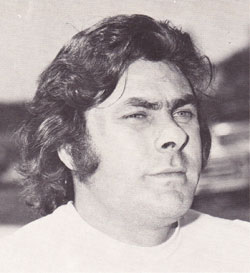 |
Compared to those of other former world champs, Phil Castronovo’s Funny Car driving career was short-lived – spanning just a handful of seasons – but the recently departed 1971 NHRA class kingpin certainly left a legacy of performance, and the continuing efforts of his family in the class after he left the cockpit also cemented its place in class lore.
The Custom Body Enterprises machines fielded by the Utica, N.Y.-based family were among the sharpest-looking in the class, as befits a family that made its living between Funny Car dates with a custom paint emporium.
Phil was the third of four Castronovo brothers, behind Fred and John and ahead of Victor. Fred, Phil, and Victor worked at Custom Body while John had his own respected body-shop business (though he did occasionally work with his brothers). Fred had formed Custom Body Enterprises in the early 1960s, specializing in custom paint jobs with a fondness for old-school metalflake and pearls that were unique to the area. Because custom work alone could not support the business, they also did regular collision work, and Fred created an offshoot company, Custom Speed Shop, in the same building that sold a popular collection of speed parts. A second speed shop later was opened Rome, N.Y., about 15 to 20 minutes away from Custom Body in Utica but close to Griffiss Air Force Base. During that muscle car era there were always Boss Mustangs, Z28 Camaros, Hemi Cudas, and Road Runners parked outside the shop, and the airmen from Griffiss would spend their paychecks on wheels, tires, intakes, headers, and more. When the muscle cars died off, so did the speed shop business.
Most race fans know that Fred was the wallet and the guiding force behind the brothers’ dragstrip efforts, and with Phil now gone and John also passing earlier this year (July 7), I was fortunate to be contacted by Victor’s son, Fred, who took full advantage of the family gatherings surrounding the planning of Phil’s services to get their remembrances about the man who was a dad, a brother, an uncle, and most of all a racer.
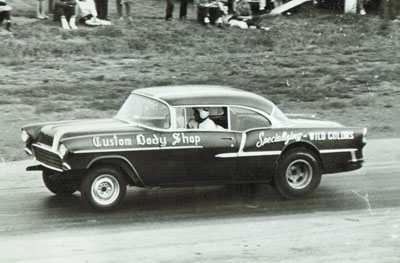
(Above) This B/Gas '55 Chevy was the Castronovo brothers' first race car and was followed (below) by an A/Gas Willys (below).
|
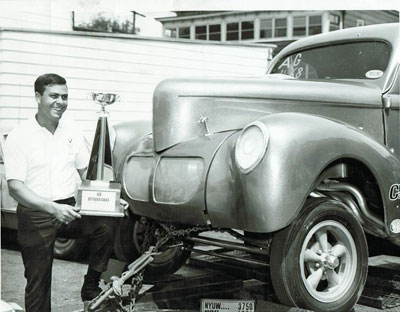 |
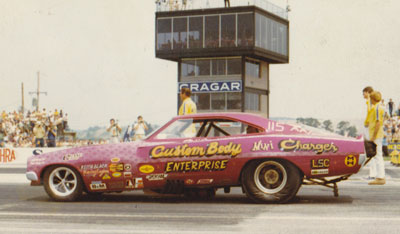
Their first Funny Car sported a custom paint scheme befitting their professions.
|
“My dad described Phil as a dedicated racer,” reported Fred. “He drove hard and worked hard. He had that killer instinct to win. Match race or national event, Phil was determined to put the Custom Body Funny Car in the winner’s circle.”
According to their nephew, the racing partnership of Phil and Fred started early on the streets, where Phil displayed a natural talent behind the wheel and Fred often staked Phil, and both reaped the rewards. It wasn’t long before Phil became known on the streets as “the guy to beat,” but the brothers decided to take their skills to the racetrack, first with a B/Gas ‘55 Chevy that they had built and raced locally, and, beginning in 1967, with an A/Gas `39 Willys with which they also traveled to more distant meets.
As the new Funny Car class began to gain popularity in the late 1960s, the brothers leapt on the bandwagon with a Mini Charger that carried the Custom Body name into the fuel ranks for the first time.
Recalled Fred, “Because custom bodywork, lace, and metalflake was what they specialized in, it was only natural that my father and my uncle Fred apply a wild cherry metalflake and lace paint job to the new Fiberglass Trends body. My uncle Phil wasn`t much of a bodyman or painter; he was always the driver, and my uncle Fred and my dad were always the bodymen. My uncle Fred was mostly known as the car owner throughout his racing years, and my father was always the quiet, behind-the-scenes guy, but always known locally as the best because of his exceptional talent as a bodyman and painter and, of course, for maintaining my uncle Fred`s beautiful cars throughout the years. My dad also lent his helping hand to many fellow racers as they passed through town and stopped by the shop for a few days between races. That in itself was something as it was quite the sight to see five or six different race cars parked at the Custom Body shop on any particular day.”
The car’s performance quickly improved when the brothers hired Phil Roberts to tune the car, and in 1970, the brothers won the Division 1 championship. With Phil`s reputation growing quickly, the car was a popular booking for track owners. According to Victor, Phil was a real showman, too, often driving back up the strip to the starting line after winning an event, the car still cackling and parachute still deployed; the crowd would go crazy.
According to Fred, “Because the Funny Car was so popular, it attracted many local hot rodders to the shop, and it was a win-win situation for my uncle Fred, the body and paint/speed-shop business and drag racing team. That’s where the Custom Body Enterprises name came about. I will stress that the racing organization and name Custom Body was all my uncle Fred. While he was a good street driver himself and owned some of the hottest and fastest cars back in the day, he mainly enjoyed his position as car owner of the Custom Body Enterprises Funny Car and did extremely well throughout the years. He had very high expectations of the people that worked for him and demanded the best. For an independent, he did pretty well.”
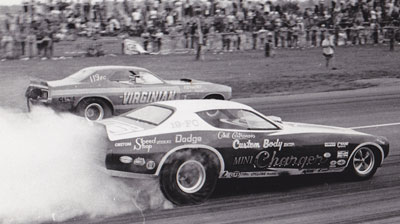
(Above) A new Charger was built for 1971 and carried Phil Castronovo to the NHRA world championship. (Below) The following year, the massive blower explosion in Indy led to family pressure for Phil to leave the cockpit.
|
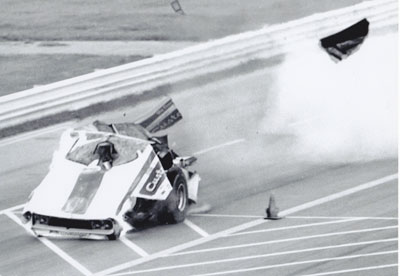
Steve Reyes photo
|
A new Mini Charger was built for the 1971 season and netted a runner-up at Le Grandnational in Montreal and the championship-crowning victory at the World Finals, capped with a final-round victory over Jake Johnston.
“Both Phil and Phil Roberts really came together for a successful season,” recalled Fred. “Although some may argue that he won at the World Finals by luck, those who were there with them recall to this day how they were discussing their strategy to keep the car competitive on that particular day since a lot of guys were running faster than them but breaking parts in the process. Their conservative approach got them to the final and in the winner’s circle.”
Another new car was built for 1972, a car that took Best Appearing Car honors and the No. 1 qualifying berth at that year’s Summernationals, but it became the Best Disappearing Car after a booming finish-line explosion and subsequent contact with the guardrail at the U.S. Nationals destroyed the car and pretty much ended Phil’s career behind the wheel. Tom Prock took over the controls of the car and continued the team’s success with several final-round appearances and top 10 finishes.
“My grandmother stressed the need to take Phil out of the car, telling my uncle Fred that if something tragic were to happen, our family would be devastated,” recalled Fred. “In the time my uncle Phil was driving, many cars were blowing up and burning to the ground. My dad recalls pulling many drivers out of their cars. So concerns for my uncle Phil were very high. We are a tight-knit Italian family, and, to be quite honest, Tom Prock became as close as family gets. He would spend weeknights and weekends at one of the brothers’ houses or my grandmother’s house having Italian dinners. His wife and kids were here often with him, and everyone became very close. Even after he left my uncle Fred to start the Detroit Tiger Funny Car, many of the photos I have show him parked right alongside my uncle Fred`s truck and trailer at various races. They`ve remained close friends throughout their lives, and I would be confident in saying I personally think Prock did the most for my uncle Fred in terms of racing the car and making appearances. He raced a lot and knew a lot about the car.”
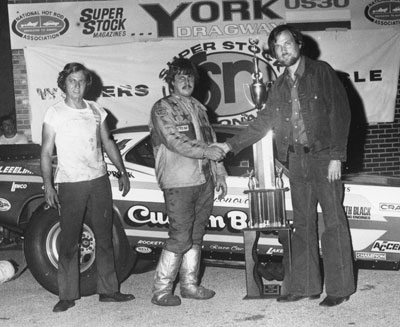
(Above) Tom Prock, center, took over the wheel from Castronovo and worked well with crew chief Phil Roberts, left, in a number of cars, including the Challenger (below) and the Dodge Dart (bottom) that Prock drove to runner-up finishes at the 1975 Gatornationals, Summernationals, and Grandnational.
|
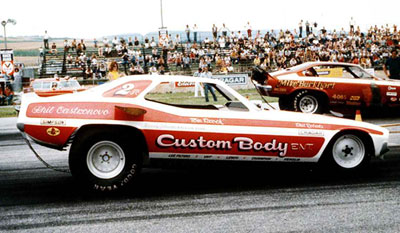 |
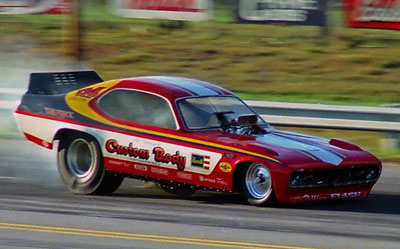 |
Prock was eager to share his memories of his time with the Castronovo family. “I was quite fortunate to get the chance to drive for Freddy and Phil,” he said. “At the time of my intro there, Phil's driving career was almost over at his mother's demands. Fred, however, was not about to stop; he had hired Phil Roberts to maintain the car and asked if I would be interested to drive it. His choice of equipment was always the best, and so along came a great line of Woody Gilmore-built Funny Cars through the ‘70s. Roberts and I lived in New York and ran as many as 75 match races a year. The years that I spent there were the very best, and I will surely miss Phil. Fred and Philly were one of a kind."
Even after he left the cockpit, Phil remained a people’s favorite after he opened Novo's Pizzeria just across the street from Custom Body, and it became a hot spot for pizza and lunches and car guys. Inside, the establishment was filled with all of his racing memorabilia.
The younger Fred, 38, married with a 2-month-old son and still living in Utica, idolized his father and his uncles and followed them into the business with his own collision shop just five minutes from his uncle Fred. (Fred remains busy and still owns another business in Utica, an Italian restaurant called Castronovo's Original Grimaldi's, which also is decorated with Funny Car memorabilia.)
“I`ve stood alongside my father my entire life and looked up to him and to all of my uncles,” he said. “These guys were a tough, rare breed. Old-school guys. They cut their education short for the love of cars and drag racing. I admired them to the point of following in their trade. While collision work is the norm, I love custom work and still consult my dad when I take on something of an old-school nature and visit my uncle Fred.
“As the years have passed and I became more interested in their racing career, I took every opportunity I could to purchase something related to their racing era. I`ve gathered a large collection of photos and memorabilia, and I can proudly say I am the biggest Custom Body Enterprises racing fan.
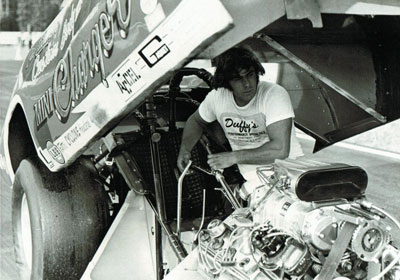 |
“My uncle Phil always had a great personality and charming character,” he added. “He was the type of guy to walk in a room and make everyone smile. He had charisma. I was always impressed growing up when I would randomly be with him somewhere when someone would recognize him, slowly approach him, and ask for his autograph. For a young kid to stand beside such a man like him, I grew up always looking up to him, admiring him.
“As we said goodbye this week, we sadly spoke of his better days and recalled many great memories,” said Fred. “The services brought many old-time friends, and I proudly stood in the receiving line along with the rest of my family amazed at how many grown men were crying. I was shocked at how many lives he left an impression on. I can`t express enough what a true gentleman he was and how much he impacted my life. Again, as a young kid always being with and being hugged by a champ, what more could a kid ask for. I will miss him.”

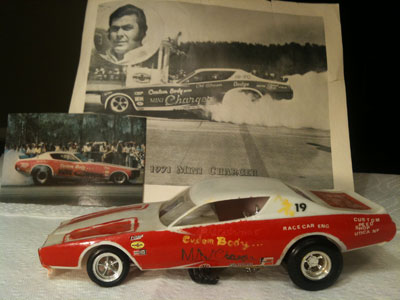 |
Fred Castronovo may consider himself a big Custom Body fan, but Chris Williams might surely be a close runner-up.
“Phil was my boyhood idol,” he wrote. “I think I only spoke to him briefly once; I had trouble getting my nerve up. In 1972, he and Fred opened a custom speed shop in Rome, where I grew up. I would ride by that shop all the time on my Stingray to see if he was there. One day, he was out on the street looking at his Corvette (I was disappointed he did not drive a Mopar), and I was able to briefly talk to him. Another time, I went in the store when he was there to see if he had a handout of the Funny Car. He said he'd bring one the day after next. I got so excited I went in the next day instead of waiting. The handout was there, but not Phil. I was too nervous to go back the following day to thank him!
"My brother and I visited with Fred Castronovo at their shop about two years ago. As we spent time with Fred, we realized how simple racing was back in the '70s. Fred said they needed a few sets of Hemi heads, and when they could not get the parts, they bought a couple of Hemi-powered Mopars from the dealer and pulled the heads off! I still have all the handouts and Custom Body photos that I had hanging on my wall as a boy. I have attached a picture that I just took of the model of Phil's 1971 championship-winning Mini Charger I built as a boy in 1972. I also own a couple of Revell Charger Funny Car kits, and I have been planning on building a quality replica of the '71 Mini Charger; hopefully Phil's passing will inspire me to actually do it."
And, if we've learned anything today, it's that Phil Castronovo inspired a lot of people. Rest in peace, champ.



















































